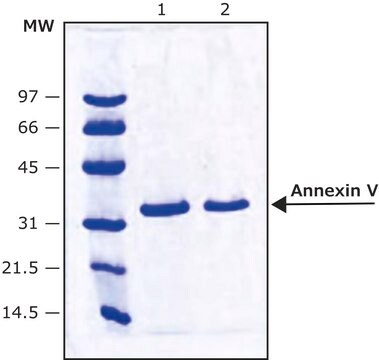SRP8058
Tim-4 (human): FC (human)
recombinant, expressed in CHO cells, ≥98% (SDS-PAGE)
Synonym(s):
PC cell-derived growth factor, TIM4, TIMD4
Sign Into View Organizational & Contract Pricing
All Photos(1)
About This Item
UNSPSC Code:
12352200
NACRES:
NA.32
Recommended Products
biological source
human
recombinant
expressed in CHO cells
assay
≥98% (SDS-PAGE)
form
lyophilized
mol wt
monomer 54 kDa by calculation
packaging
pkg of 100 μg
impurities
<0.06 EU/μg endotoxin, tested
color
white
UniProt accession no.
shipped in
wet ice
storage temp.
−20°C
Gene Information
mouse ... Timd4(276891)
General description
The TIM (T cell/transmembrane, immunoglobulin and mucin) family plays a critical role in regulating immune responses, including allergy, asthma, transplant tolerance, autoimmunity and the response to viral infections. The unique structure of TIM immunoglobulin variable region domains allows highly specific recognition of phosphatidylserine (PtdSer), exposed on the surface of apoptotic cells. TIM-4 (T cell; immunoglobulin; Mucin-4), also known as SMUCKLER, is a 60 kDa member of the TIM family of immune regulating proteins. TIM-4 is exclusively expressed on antigen-presenting cells, where it mediates phagocytosis of apoptotic cells and plays an important role in maintaining tolerance. TIM-4 binds specifically to TIM-1 which is also the cellular receptor for the hepatitis A virus, and has been implicated in the development of asthma. Among hematopoietic cells, TIM-1 is expressed on activated B and T cells, preferentially in the Th2 subset of CD4+ T cells. The interaction of TIM-4 with TIM-1 induces costimulatory and hyperproliferative signals in T cells.
Physical form
Lyophilized from 0.2 μm-filtered solution in PBS.
Reconstitution
Reconstitute at 100 μg/mL in sterile PBS.
Other Notes
The extracellular domain of mouse Tim-4 (aa 22-279) is fused to the N-terminus of the Fc region of human IgG1.
Storage Class
10 - Combustible liquids
wgk_germany
WGK 2
flash_point_f
Not applicable
flash_point_c
Not applicable
Certificates of Analysis (COA)
Search for Certificates of Analysis (COA) by entering the products Lot/Batch Number. Lot and Batch Numbers can be found on a product’s label following the words ‘Lot’ or ‘Batch’.
Already Own This Product?
Find documentation for the products that you have recently purchased in the Document Library.
Our team of scientists has experience in all areas of research including Life Science, Material Science, Chemical Synthesis, Chromatography, Analytical and many others.
Contact Technical Service






